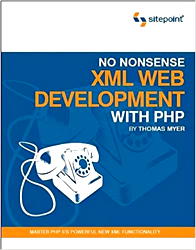No Nonsense XML Web Development With PHP: A Practical Step-by-Step Guide
reviewed by Jonathan Hoyle
|
Author: Thomas Myer SitePoint Pty. Ltd. Book Site: http://www.sitepoint.com/books/xml1/ Released: July 27, 2005 Pages:354 $40 USD, $56 CND, £ 28 GBP, €35 Euro ISBN: 097524020X Audience: Intermediate and advanced PHP programmers. Strengths: Most thorough XML on PHP book available.
Weakness:
The XML database section is too short.
|
|
With the ever-growing popularity of PHP programming, combined with the increasing usage of XML, SitePoint has published No Nonsense XML Web Development with PHP. This book is a practical guide for PHP programmers wishing to develop with XML. Note that this book is more designed for accomplished PHP developers wishing to learn XML than it is for accomplished XML programmers wishing to use PHP.
Chapter 1 is a thorough introduction to XML, explaining what it is, why you would want it and some good XML examples. Unfortunately, this chapter is also where it shows its Windows bias, as it describes various Windows browsers to use for testing your XML code, but no mention of Safari or any Mac version of a browser. Chapter 2 continues with specific XML implementations and how they are used. Between these two chapters, any PHP programmer will be fully armed to move forward.
Chapter 3 covers XML consistency and Chapter 4 continues with more browser specifics for XML programming. The following chapter is an interesting tour of XSLT, the specification for transforming XML-based documents into other documents. Programming aspects cover sorting, counting, numbering, conditional processing and more. Chapter 6 is one of the most useful chapters as it discusses XML's use with JavaScript. As JavaScript is the most popular client-side language on the web, whereas PHP is the most popular server-side language, creating and accessing XML code across both languages opens up a great deal of flexibility.
The real meat of the book finally happens in Chapter 7, as it speaks specifically to PHP programmers. Using SAX, DOM and other such technologies are reviewed in this chapter. Chapter 8's RSS and RDF gives the reader some of the most useful examples of how to use XML with PHP, which nicely leads into web services covered in Chapter 9. The final chapter all to briefly covers XML databases, which is perhaps its most powerful usage. If there is one criticism of this book, it is that it should have had more coverage in this Chapter.
Author Tom Myer has done an outstanding job pulling together the various technologies for PHP programmers. The practical examples and step by step instructions found in most of the chapters are invaluable as a teaching aid. I am surprised that there is no accompanying CD to incorporate the many examples. If you are a PHP web developer, it is probably only a matter of time before you will need to interface with XML on some level. When you do, No Nonsense XML Web Development with PHP is the ideal book for you.











